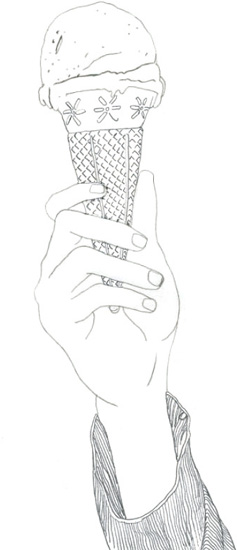Puddings and Ice Cream
Pudding at the Fish Store is really just an excuse to eat more Jelbert’s ice cream and their exceptional clotted cream. They sell both, these days, for eating later, in polystyrene cups. It is unusual if there isn’t at least one ice cream tub in the freezer between Easter and the end of October – when the shop is open – and there is an unwritten rule which decrees that anyone who passes Jelbert’s shop in Newlyn will buy for the freezer as well as themselves.
The best ice cream in the west
If the sun is shining in Newlyn on any day between the first of April and the end of October, the door of Jelbert’s will be wide open and Jim Glover or one of his team will be filling cornets or stuffing tubs with ice cream. There is only one flavour – vanilla – and it comes with or without extra clotted cream. Whether to have a Cadbury’s chocolate Flake to tuck into the ice cream or to go for a large as opposed to medium-sized cornet are the only decisions to be made. The small shop excites daily queues during a hot summer and it’s not unusual to spot a suited businessman belted up inside his saloon or a builder and his mate parked up opposite risking a parking fine to enjoy their Jelbert’s. Fisherman too, from nearby Newlyn Fish Market, aren’t immune to the lure of the shop, queuing alongside schoolkids and holidaymakers. Anyone who knows anything knows that Jelbert’s ice cream has no competitors. It is simply the best.
Jim is unclear exactly when the business originated but Jelbert is his mother’s family name and he thinks the shop started early in the 1900s, although there is no real record before the end of the Second World War. Originally, the ice cream was allied to the family milk round, which goes back to his great-grandfather’s day, when milk was delivered door to door in churns. Jim remembers as a small boy taking the milk to very steep places in a jug, and pouring out with a measuring cup directly into people’s containers. There were no bottles. The business moved into the current location when milk rationing ended and ice-cream making started again. At that stage all the manufacturing was done in his grandmother’s backyard, in the house where Jim was born. Every day the mix would be prepared by hand and the family would take it in turns to sit at the truncated barrel with its steel cylinder and internal steel paddles, winding the handle, turning it through tubs of salted ice until the churned milk got stiffer and stiffer and the job harder and harder.
Jim took over the business shortly after machines were installed in a tiny factory set up in a cottage used by Belgian evacuees during the war in the lower part of old Newlyn. These days the milk and cream are bought from a local dairy but the ice cream is made to the same formula daily, using fresh milk, butter and cream.
It must have been tempting at some stage or other to expand and open other shops. Fortunately Jim, like other Jelberts before him, appreciates that it is only by controlling the product and not expanding or diversifying that it’s possible to maintain the standard.
So next time you have to queue for your Jelbert’s, don’t complain but remember to thank your lucky stars that it will taste exactly the same as it always has done.
